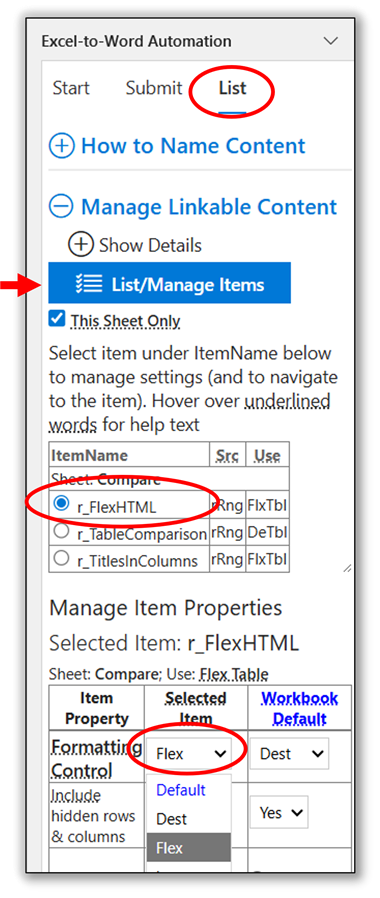Comparison of Table Types
The add-in allows you to update Word and PowerPoint tables in 3 ways: 1. Destination-formatted tables, 2. Excel-formatted (Flex) tables, and 3. Via an image of the source range/table. The table below compares these 3 methods.
Flex Tables provide more control and customization than the default Destination Tables. They make it easy to apply Excel formatting directly to Word or PowerPoint tables, giving you faster updates and more flexiblity. Learn how to switch to Flex Tables
|
|
Tables (Destination-formatted) |
Flex tables (Excel-formatted) |
Table images |
|---|---|---|---|
|
Summary |
|
|
|
|
How it Works |
Only the Excel table text/values are transferred to Word/PowerPoint. The text is updated in the destination table, but the table format is not modified. The add-in resizes the destination table (by inserting/deleting rows/columns) to match the size of the Excel table/range. |
Tables (including format) are created in Excel and replace the Word/PPT tables. |
The Excel add-in creates an image of the range which replaces the Word/PowerPoint image |
|
Compatibitliy |
no limits (works in Word & PowerPoint; Windows, Macs & Online; Add-in & Cloud updates) |
Now works with Word and PowerPoint. Not compatible with Office on the Web (Office Online) |
No limits |
|
Size in desination file |
Small |
Small-Medium |
Large transfer and file sizes |
|
Update speed |
Word add-in updates can be slow for large tables Cloud updates are fast |
Fast: can update dozens of large tables in seconds |
Fast |
|
Formatting |
|
|
|
|
Merged Cells |
Yes, with limits |
Yes |
Yes |
|
Excel Named Ranges |
Yes |
Yes |
Yes |
|
Excel Tables (Data Tables) |
Yes |
Yes (Table Styles are ignored ^2) |
Yes |
|
PivotTables |
Yes |
Yes (PivotTable Styles are ignored ^2) |
Yes |
|
Conditional Formatting |
No |
No |
Yes |
| HTML Formatting | No | Yes - cells can contain HTML content in Word (but not PowerPoint) | No |
|
Works with Cloud Updates (including Personal and Business templates) |
Yes |
Yes (inserts line break after the table) |
Yes |
|
Table re-sizing |
Yes, it inserts/deletes rows/columns to match the Excel table size. There are limits ^3 |
Yes - it recreates and replaces the destination (Word) table |
Yes - it replaces the destination image |
|
Appropriate for large financial tables and reports |
Not likely (slow, some formating limitations) May be good for Cloud Updates (incl templates) |
Yes |
No (large file sizes) |
|
Potential Issues |
Slow update speeds for large tables Formatting limitations ^3 |
Requires some content between tables ^4 Cloud updates insert a line break after the table Office Online limitations ^5 |
Low resolution > make font larger in Excel Large file size |
^1 Table images Mac and borders workaround: in Excel: copy the range, paste it as a "Linked Picture", then name that shape (starting with your prefix)
^2 When using Excel Tables (e.g. "Format as Table"), as opposed to named ranges, the Table Syles are ignored. You must explicitly apply formats (font color/size, background, borders, etc.) to appear in the Word table. All formats applied to named ranges can appear in the Word table. PivotTables work the same way as Excel Tables.
^3 Dest Table formatting limitations: The add-in inserts/deletes rows/columns (before the last row/column) to match the Excel table size. Uses the next-to-the-last row/column as the style template. With complex formatting when resizing is needed, it may insert/delete row at wrong location resulting in misplaced/offset row formats.
Also, the add-in can't resize both columns and rows in 1 update (though Cloud Updates can).
^4 Word requires some content (e.g. a line break) after a Flex table if there is another table (any type) directly below it
^5 Office Online may experience other issues, such as some appearance differences and some other incompatibilities. Office on Windows or Macs is recommended for Flex tables.
Switching to Flex Tables
Flex Tables are the preferred method for updating tables because they provide more control and flexibility than the default Destination Tables. They make it easy to apply Excel formatting directly to Word or PowerPoint tables, giving you faster updates and more customization options.
How to Switch a Range, Table, or PivotTable to a Flex Table:
- In the Excel add‑in, go to the List tab and select List/Manage Items.
- Choose the item you want to update.
- Change the Formatting Control setting to Flex.
Why Use Flex Tables?
- Apply Excel formatting directly to Word or PowerPoint tables.
- Customize the look and feel of your tables with more options.
- Fast and easy to format, with greater flexibility than Destination Tables.
Note: If your documents are already linked using Destination Tables, you may not want to switch, since Flex Tables change how updates are applied.
